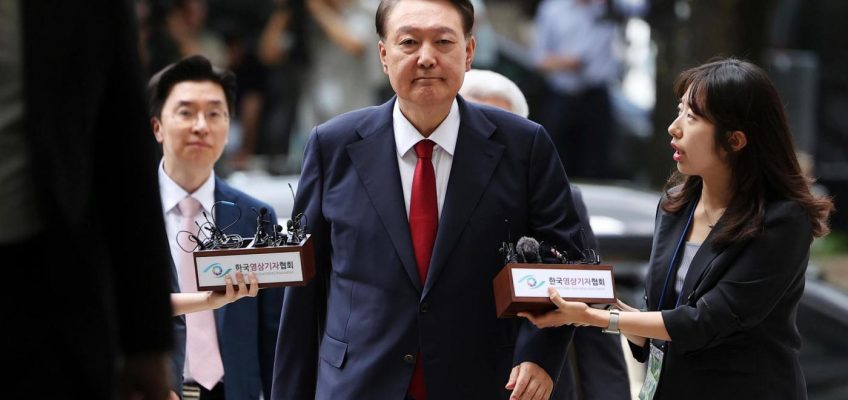By SOPHIE AUSTIN, Associated Press
SACRAMENTO, Calif. (AP) — President Donald Trump’s administration sued the California Department of Education on Wednesday for allowing transgender girls to compete on girls sports teams, alleging the policy violates federal law.
The move escalates a battle between the Republican administration in Washington and Democratic-led California over trans athletes.
The lawsuit filed by the Justice Department says California’s transgender athlete policies violate Title IX, the federal law that bans discrimination in education based on sex. The department says California’s rules “are not only illegal and unfair but also demeaning, signaling to girls that their opportunities and achievements are secondary to accommodating boys.”
U.S. Attorney General Pam Bondi warned other states that allow trans girls to compete in female athletics that they could also face challenges by the federal government.
“If you do not comply, you’re next,” she said in a video posted on social media. “We will protect girls in girls sports.”
Related Articles
Trump sends out tariff letters to 7 more countries but he avoids major US trade partners
Trump’s trade blitz produces few deals but lots of uncertainty
Texas flooding, and politics around it, underscore the challenges Trump faces in replacing FEMA
How Americans think the government should respond to natural disasters, according to recent polls
Biden’s former doctor refuses to answer questions in House Republican probe
The state Education Department and the California Interscholastic Federation, the governing body for high school sports that was also named a defendant, said they would not comment on pending litigation.
California has a more than decade-old law on the books that allows students to participate in sex-segregated school programs, including on sports teams, and use bathrooms and other facilities that align with their gender identity.
Trump criticized the participation of a transgender high school student-athlete who won titles in the California track-and-field championships last month. Assistant Attorney General Harmeet Dhillon wrote in a letter after the meet that the California Interscholastic Federation violated the Equal Protection Clause of the Constitution by allowing trans girls to compete against other female athletes.
The federal Education Department earlier this year launched an investigation into California’s policies allowing athletes to compete on sports teams consistent with their gender identity. The agency said last month that the policies violate Title IX, and it gave the state 10 days to agree to change them. But the state this week refused.
Trump also sparred with Maine’s Democratic governor over that state’s transgender-athlete policies. Gov. Janet Mills told the president in February, “We’ll see you in court,” over his threats to pull funding to the state over the issue. His administration filed a lawsuit in April alleging Maine violated Title IX by allowing trans girls and women to compete against other female athletes.
The Justice Department’s lawsuit against California says its policies “ignore undeniable biological differences between boys and girls, in favor of an amorphous ’gender identity.’”
“The results of these illegal policies are stark: girls are displaced from podiums, denied awards, and miss out on critical visibility for college scholarships and recognition,” the suit says.
Meanwhile, on his podcast in March, California Democratic Gov. Gavin Newsom angered some party allies when he questioned the fairness of trans girls competing in girls sports. GOP critics have called on the governor to back a ban, saying his remarks do not square with his actions.
Gov. Gavin Newsom, R-Calif., speaks to a crowd gathered at an event space during a two-day swing through South Carolina on Tuesday, July 8, 2025, in Bennettsville, S.C. (AP Photo/Meg Kinnard)
The issue is part of a nationwide battle over the rights of transgender youth in which states have limited transgender girls from participating on girls sports teams, barred gender-affirming surgeries for minors and required parents to be notified if a child changes their pronouns at school. More than two dozen states have laws barring transgender women and girls from participating in certain sports competitions. Some of the policies have been blocked in court.
Trump signed an executive order in February aimed at barring trans girls and women from participating on sports teams consistent with their gender identity.
Proponents of a ban, including the conservative California Family Council, say it would restore fairness in athletic competitions. But opponents, including the LGBTQ+ advocacy group Equality California, say bans are an attack on transgender youth.
In Oregon, three high school track-and-field athletes filed a federal lawsuit against the state this week seeking to remove records set by transgender students and prevent them from participating in girls sports. They say allowing trans girls to compete against other female athletes is unfair and violates Title IX.
The U.S. Education Department launched investigations earlier this year into Portland Public Schools and the state’s governing body for high school sports to over alleged violations of Title IX in girls high school sports.
Associated Press writers Alanna Durkin Richer in Washington and Claire Rush in Portland, Oregon, contributed.
Austin is a corps member for The Associated Press/Report for America Statehouse News Initiative. Report for America is a nonprofit national service program that places journalists in local newsrooms to report on undercovered issues. Follow Austin on X: @sophieadanna




